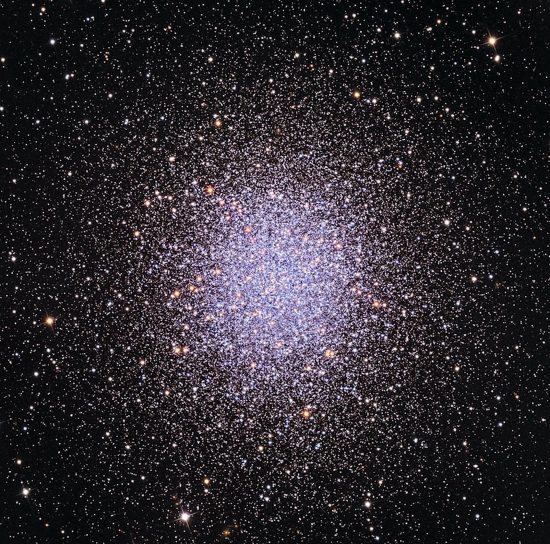
August 26, 2020
Globular clusters should be blue, because their stars should be young.
Each new observation from the Hubble Space Telescope or the Chandra X-ray Observatory adds fuel to the Electric Universe fire. Research groups, on the other hand, are constantly observing celestial bodies that require them to attach addenda to existing theories.
Astronomers using the Hubble Space Telescope (HST) report that there are clusters of stars orbiting another galaxy over a billion light years away that aren’t behaving as conventional understanding suggests: rather than being blue they are red.
Modern astronomers measure the Universe based on expansion out of a primordial explosion. They believe that objects farther out into space are representative of the Universe as it was closer to its beginning. Galaxies located a billion light years away are supposed to be as they were a billion years ago. The expectation is that stars observed at that distance should be youthful, near the beginning of their lives, with rich supplies of hydrogen fuel. In that case, they should be burning hot and blue, radiating high frequency X-rays and extreme ultraviolet light.
Globular star clusters are normally found in a halo around galactic nuclei. They are thought to be structures that have been gravitationally attracted to the host galaxy because many of them have the appearance of age—they have large populations of red stars that are supposed to be old. Some theories speculate that the clusters might have been ejected from a host galaxy, or that they formed in conjunction with a host galaxy.
The ratio of blue stars to red stars is commonly used to indicate an overall age of one cluster with respect to other similar globular clusters. As the Hubble team pointed out, however, many clusters are filled with stars that appear much too red for them to be so young.
Stellar evolution is supposed to go through various stages of thermonuclear fusion, transforming hydrogen into heavier elements. The mass of a star is supposed to provide a clue to how old it is, because the ratio of different elements is said to provide an idea of how long it took to convert its original mass into those other elements.
Conventional understanding says that stars fluctuate in output when their temperatures change due to changes in the fusion reactions. They turn red as one phase ends because the atmosphere expands and the outflow is spread over a larger area, and then they turn yellow or white again as another element starts to fuse into still heavier atoms. However, the Hubble team is quoted as saying, “It’s possible there’s something about stellar evolution we don’t understand.” The irony in that statement speaks for itself.
In a previous Picture of the Day, Dr. Donald Scott, in his book The Electric Sky, showed how the Hertzsprung-Russell diagram of stellar evolution can be improved by adding another scale to the horizontal axis: Current Density at the Star’s Surface. The means that the way stars appear when viewed through optical telescopes or X-ray detectors will not be dependent on age and distance, but on the amount of energy flowing into the star from the surrounding environment. The greater the electric current, the hotter and brighter the star will appear.
As Dr. Scott wrote:
“In the Electric Star model, perhaps the most important factor in determining any given star’s characteristics is the strength of the current density in Amperes per square meter (A/m^2) measured at that star’s surface. If a star’s incoming current density increases, the arc discharges on its surface (photospheric tufts) will get hotter, change color (away from red, toward blue), and get brighter. The absolute brightness of a star, therefore, depends on two things: the strength of the current density impinging into its surface, and the star’s size (the star’s diameter).”
So, in reality, the stars in the globular clusters are merely obeying the cosmic forces permeating the Universe: electricity. It is possible that they are not as far away as they appear. They may not be nearly as old as astronomers think, because they are not behaving according to gravity and redshift theories but according to theories of plasma cosmology.
Stephen Smith
The Thunderbolts Picture of the Day is generously supported by the Mainwaring Archive Foundation.












